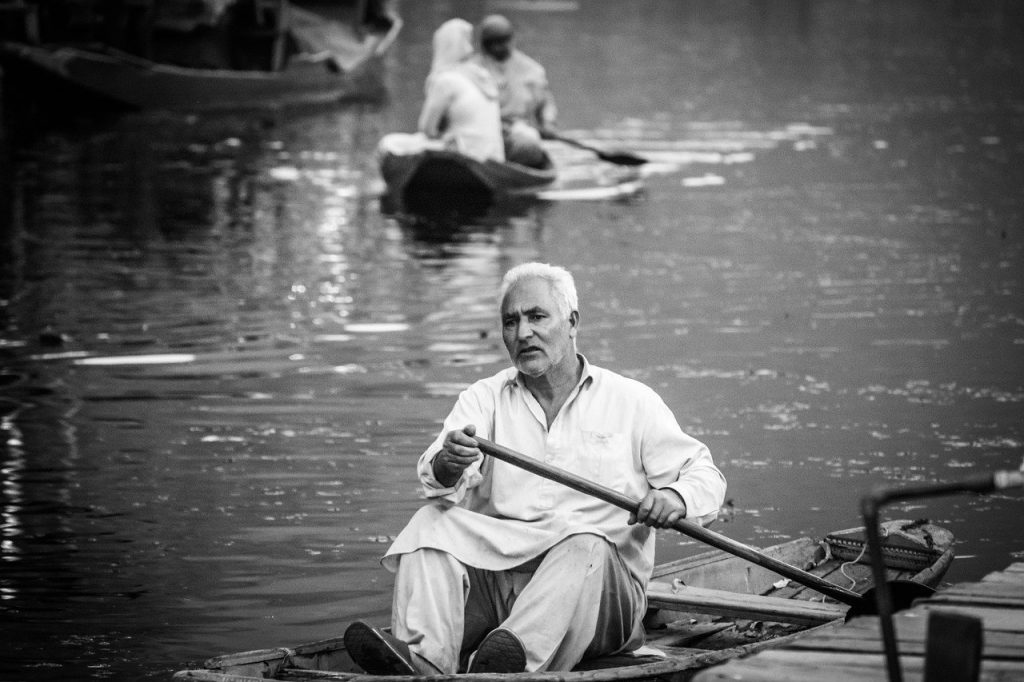The traditional attire of men and women in Kashmir is the Pheran. People in the Kashmir Valley and Kashmiris residing in the Chenab Valley, use pheran (also called phiran) as their traditional outfit. Cotton pherans are worn during the summer season, while woollen pherans are used in the winters as a protection from the severe cold and the snow. Pheran is known to have been the traditional dress of Kashmiris since the 15th century CE. This outfit is also the most popular dress of Jammu and Kashmir, and worn by males and females alike.
The traditional pheran, which was in popular use till the late 19th century CE, extends to the feet. Pherans of the modern times extend below the knees. It is mostly worn with a suthan inside, while wearing a suthan is not mandatory inside a long pheran. This outfit does not have side slits.
Pherans worn by women have colourful floral designs and intricate embroideries, while those worn by men are simpler and without designs. Muslims wear a knee-length pheran while Hindus wear longer pherans.
Poots is an outfit of a thinner material and worn beneath a pheran. The purpose of wearing this outfit is to save the pheran from the burns due to kangri and also to provide more warmth.
Kashmiri Pandit women wear a taranga, a headscarf that gets smaller towards the heels. It was mostly worn till the 1960s and in some parts of Kashmir, it is still used. Kashmiri Muslim women wear a headgear called kasaba, which is padded with a turban and pinned together using brooches. A silk or pashmina veil is pinned to the kasaba. A Thoud kasaba is worn by married women, mostly from affluent families. It is worn like a crown. Bonn kasaba is used by commoners and tribal women and is like a bandana. Women from the royal families were known to wear kundan kasabas.
Since the later part of 19th century, loose suthans (shalwars) and churidars of Punjab started being used by the Kashmiris. A suthan or churidar pajama may be worn with a pheran. While the suthan is loose similar to the Dogri suthan worn by the people of Jammu, some variants are similar to shalwars worn in Afghanistan. Since the 1960s, most Kashmiris use the straight cut Punjabi salwar.
History of the Pheran
It is believed that Mughal Emperor Akbar introduced the pheran in Kashmir. Some historians think that Persian travellers invented this long garment to protect themselves from the harsh winters in the Kashmir Valley.
It is said that Emperor Akbar promoted the pheran among Kashmiris. During the Afghan rule that lasted from 1753 to 1819, the rulers forced Kashmiri men and women to wear the pheran. Though Kashmiris disliked Mughals and Afghans, they got habituated to the pheran and started liking this attire. Even during the Sikh and Dogra rule, pheran continued to be the traditional dress of Jammu and Kashmir.
In recent years, pherans have been defamed as they allow for easy carrying of weapons and have been used by militants. During the 1990s, militants used to carry fire arms and hide AK-47 rifles inside their pherans. If the forces saw anyone wearing a pheran, they were alerted for the possibility of that person carrying weapons inside this long garment. Although this has changed now, the pheran has been linked for a long time, with the militancy in Kashmir.
The Modern Kashmiri Dress
Today, many politicians don the pheran during public addresses and official meetings. Many modern designs of this outfit have gained popularity not just in Kashmir, but across India. Women can be seen wearing pherans in bright colours and designs for formal occasions. The modern pheran is shorter than ankle-length or knee-length and sometimes it has side-slits. It is worn with a pair of jeans or with a shalwar. The newest entrant into the world of Kashmiri outfits is the LARK raglan pheran, a mix of the western raglan coat and the traditional attire. Kashmiri women today, can be seen mostly wearing a shalwar kameez and not a pheran.
Thus we can see that the pheran has come a long way from being the traditional dress of Jammu and Kashmir which it still is, to being a fashion statement and an outfit flaunted by people in many parts of India and by Kashmiris staying abroad.



